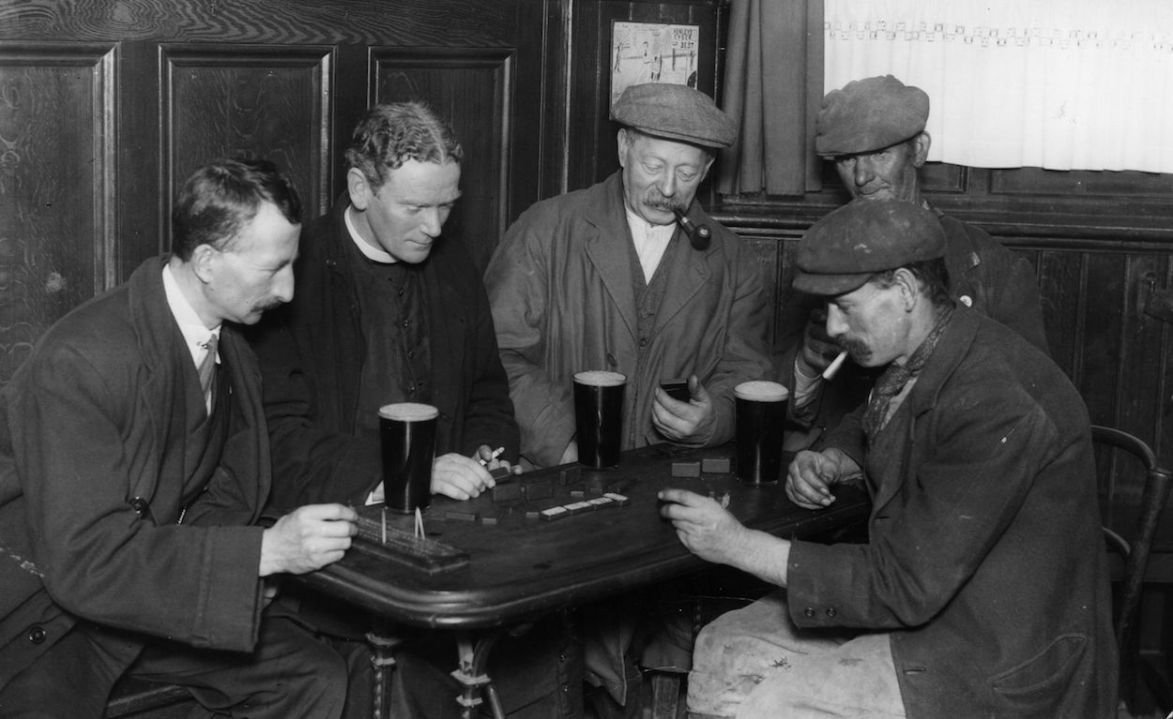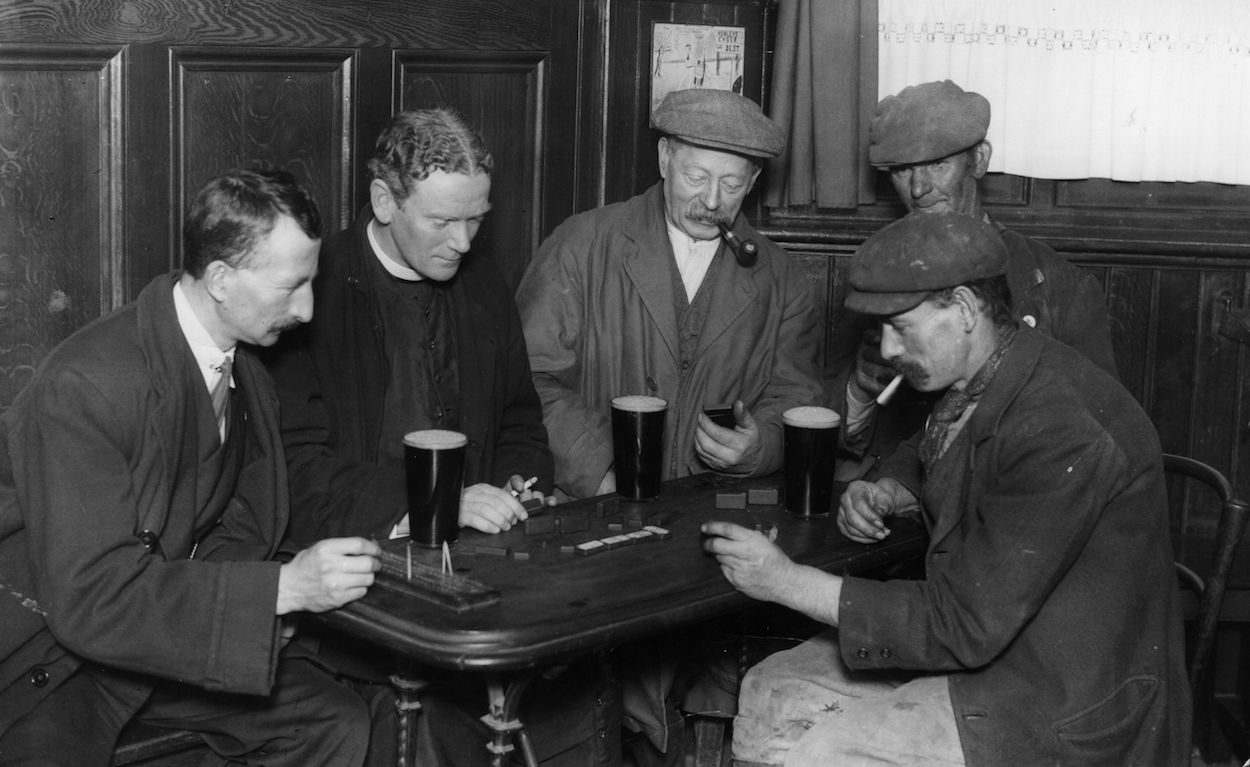From the outside, it appeared derelict – not an uncommon thing to find when visiting an unknown establishment based solely on a listing in an old copy of ‘The Good Pub Guide’. But a chap walking past with his labrador reassured us: ‘She usually opens at noon.’ When we returned an hour later it was immediately plain that the pub was still in use – you could hear music coming from inside. This turned out to be from a five-piece acoustic string band who were seated by the fire, playing ‘I’ve Just Seen a Face’.
When asked what wines she had, she gave the classic no-nonsense reply: ‘Red or white’
The Three Kings, in the village of Hanley Castle, near Malvern in Worcestershire, dates back to the 15th century and has been owned by the same family since the early 20th. She was a formidable presence behind the bar – when asked what wines she had, she gave the classic no-nonsense reply: ‘Red or white’. Her domain, the bar, was draped in old hop vines, and busy with glasses, tankards, jars of mustard (English, not Dijon) and other assorted clutter. Instead of the usual ‘gourmet’ crisps, the only snacks on offer were homemade pickled onions and eggs in old jam jars. In contrast to the rudimentary wine list, the beers were more considered: locally brewed (and properly served) cask ales. That fire was almost the only light in the room – even at lunchtime the atmosphere was crepuscular. The smell was of woodsmoke and spilt beer.
The Three Kings, it quickly emerged, was cash only. Card-centric as I have become, with just an emergency paper fiver on me, I was concerned I wouldn’t have enough to afford two drinks. But our round (a half of Butty Bach and a white wine of unknown provenance) cost just £4.
This sublime and completely unexpected piece of pub heaven came just a few days after I had written a piece here bemoaning the syndrome whereby old pubs have their atmosphere destroyed by clumsy modernising refits. In The Three Kings, I’d found a pub that had been preserved (or perhaps pickled) for decades.
We’d been on a brief tour of the western Cotswolds and the Malvern Hills that had taken us to quite a number of very decent pubs: The Fox at Broadwell, The Snowshill Arms near Broadway and The Olde Anchor at Upton-upon-Severn being the previous highlights. But none of these were a match for The Three Kings because, although the modernising in those had been sensitive, it had still taken place – whereas it simply hadn’t here. The Three Kings falls into a category of what I would call ‘unmessed-about with’ pubs, which is to say those that have acquired great charm over a long period by being left alone to age gracefully.
Perhaps the only comparable place we’d visited on our several-days-long pub crawl was The Woolpack in Slad, Gloucestershire (the old inn famously associated with Laurie Lee and Cider With Rosie). But even here, although they’d left the old fittings and signage intact, they still served food. Top-end food, it must be said, of good London restaurant quality. But this was still enough to disqualify The Woolpack from the unmessed-about category: even if discreetly so, it was too fancy to count.
So what others are there? There’s The Bridge Inn on the River Exe, at Topsham, Devon, which dates to the 11th century and has been run by the same family since the 1890s. Then there’s The Cresselly Arms at Cresswell Quay in Pembrokeshire, where there’s no formal bar, just a tap room out back. On a memorable Christmas visit, the local hunt met outside with the hounds running amok in the beer garden. Similarly bar-less is Square and Compass at Worth Matravers in Dorset. The first time we visited, there was a fog so thick that you couldn’t see the pub until you were within touching distance. It’s so quaint you almost expected to see Gabriel Oak having a cheeky half before heading back to his sheep. There’s also The Red Lion in Romney Marsh and The Halfway House at Brenchley, both in Kent; The Goose and Cuckoo in the Brecon Beacons; The Woodman at Wild Hill in Hertfordshire; The Cats outside Maldon in Essex; The Bell Inn at Aldworth in Berkshire; and The Haunch of Venison in Salisbury.
Such establishments are necessarily unusual in London. Perhaps the standout examples are The Grenadier in Belgravia and The Nags Head in Knightsbridge, as both contrast sharply with the gleaming, moneyed world on their doorsteps by remaining defiantly unflashy within. The Coach and Horses in Soho has also doggedly resisted change.
Mentioning my theory that these unmessed-with places are the best pubs of all, I was inundated with nominations of others to try. Now I am working out plans to visit another Halfway House (this one at Pitney, in Somerset); The Rose and Crown in Huish Episcopi (also in Somerset); The Rose and Crown in Oxford; The Royal Oak in Wineham, West Sussex; The Bear Inn at Faversham in Kent; The Mayflower in Leigh-on-Sea, Essex; The George on Loch Fyne in Inveraray; The Laurieston in Glasgow – currently for sale so likely to change soon – and The Dyffryn Arms in Pembrokeshire.
There is every chance that a new landlord could break the spell at any one of these pubs and at any moment. So let’s cherish them while we can – and spend our money there to incentivise them not to change. Cheers.







Comments